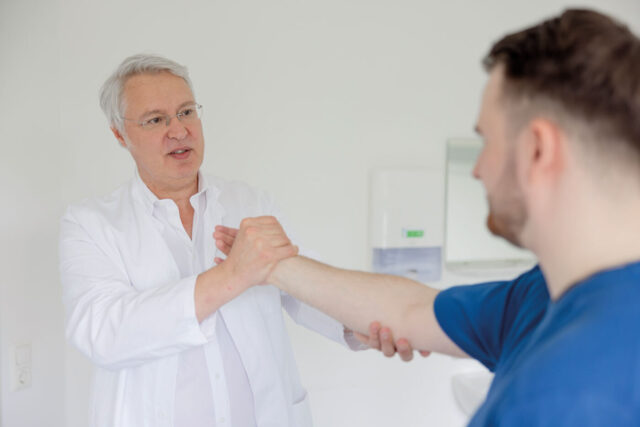The shoulder joint – from wear and tear to dislocation
An expert interview with Dr. Markus Leyh
Photo: Hanna Witte
A broken shoulder? The name of the injury sounds more dramatic than it actually is. A shoulder joint dislocation is a typical shoulder injury and, along with shoulder joint wear, is treated very frequently by shoulder specialists at Sportklinik Hellersen. In an interview with Hellersen Insight, Dr. Markus Leyh, Chief of Shoulder, Elbow, Knee Surgery, and Traumatology, explains the clinical pictures of the acromioclavicular joint.
Where exactly in the shoulder is the acromioclavicular joint located, and what is its function?
Dr. Markus Leyh: The acromioclavicular joint connects the collarbone to the acromion, a bony part of the shoulder blade. It is the only real joint connecting the entire arm, including the shoulder blade, to the torso. Ultimately, the arm is only connected to the torso via the acromioclavicular joint.
“This operation has a very good success rate.”
Dr. Markus Leyh
Chief of Shoulder, Elbow, Knee Surgery and Traumatology
And this small joint can withstand that?
Dr. Markus Leyh: More or less. Since the entire arm hangs on the small acromioclavicular joint, it is prone to wear and tear and is often affected by osteoarthritis. Basically, almost every older person has acromioclavicular joint osteoarthritis, but only very few have such serious problems that they require treatment or surgery. Conservative treatments include pain therapy, trigger point therapy, acupuncture, physical therapy, or treatment with injections into the joint. If surgery is necessary due to instability and inflammation and bone contact occurs, the shoulder joint is removed arthroscopically (minimally invasive). It is milled out to the width of a finger. This operation has a very good success rate.

Photo: Hanna Witte
What is a shoulder joint dislocation and what are its consequences?
Dr. Markus Leyh: Injuries to the shoulder joint are not uncommon. In a shoulder joint dislocation, the stabilizing structures of the joint tear. We distinguish between six degrees of severity according to Rockwood, with surgery becoming necessary from grade 4 onwards. This classification shows which ligaments are torn and whether the capsule is damaged.
If the joint is “only” unstable in one direction—similar to the movement of a piano key—it is less serious. However, in the case of an acute tear of the joint (grade 4), it is necessary to stabilize the joint within two weeks. In this case, however, the joint is also unstable at the front and back, causing the end of the collarbone to hit the shoulder roof (acromion) and causing pain. During surgery, we push the end of the collarbone back into its original position and stabilize the aforementioned planes of movement.
The capsule is sutured and the ligaments between the collarbone and shoulder blade are reinforced with a cable system. In cases of chronic instability, we remove tendons and reconstruct the anatomy.
The procedures are performed using minimally invasive arthroscopy or with an additional four-centimeter skin incision (mini-open). This allows us to stabilize the joint in all directions of instability and achieve very good results.
“This allows us to stabilize the joint in all directions of instability and achieve very good results.”
Dr. Markus Leyh
Chief of Shoulder, Elbow, Knee Surgery and Traumatology
That sounds like the injury can be treated well.
Dr. Markus Leyh: Partly. The timing of the diagnosis is crucial. And that's where we have a very big problem: as I said, in the case of an acute tear, we have to operate within two weeks. However, some patients come to us too late. The acromioclavicular joint was injured or ruptured, but it was not noticed immediately. Then the patients only come to us at the Sportklinik Hellersen four or five months later. The procedure mentioned above can then no longer be used and tendon plasty is necessary.
before
after
after
“The cause is usually a massive impact, often resulting from a fall.”
Dr. Markus Leyh
Chief of Shoulder, Elbow, Knee Surgery and Traumatology
The acromioclavicular joint carries a lot of responsibility — no wonder it sometimes causes trouble. Good thing we have specialists for exactly these cases.
What does the tendon plasty procedure involve?
Dr. Markus Leyh: We remove a tendon, usually from the knee joint, and use it to reconstruct the ligaments of the shoulder joint—similar to cruciate ligament reconstruction in the knee. Although it is a more extensive procedure, it is an effective treatment for chronic instability.
So much for the treatment. But how does a shoulder joint rupture occur in the first place?
Dr. Markus Leyh: The cause is usually a massive impact, often resulting from a fall. The injury typically occurs in athletes and is caused by an accident in which the person falls directly onto their shoulder or breaks their fall in a certain way. The force is transferred via the upper arm to the small joint, tearing it apart.



























